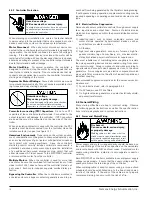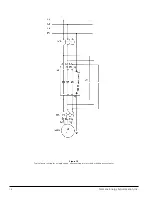
Siemens Energy & Automation, Inc.
6.4 Preliminary Checks
With main power disconnect device open and control power off,
check the following.
1. Power and Motor Connections. Check that the controller
has been properly connected to the power source and
motor per figure 12.
2. Control Connections.
Check that control power, the
start/stop control, and applicable devices have been proper-
ly connected to the control terminal board (figure 13).
3. AC Line Power Verification. Verify that each phase of the AC
line power at the disconnect device is within the rated value
of the controller as indicated on the controller nameplate.
4. Ground Check. Use an ohmmeter set to its highest scale
and observe the following.
a. Check for a ground between each controller output ter-
minal (T1, T2, T3) and chassis ground. Each terminal to
ground reading should be over 500K ohms.
b. The measurement between each input terminal (L1, L2,
L3) and ground should be over 500K ohms.
6.5 Initial Energization
1. Temporarily remove run signal connections by opening the
circuit at control terminals A1 and A2.
2. Turn on main AC power and control power to the controller;
LED 1 comes on.
3. Measure input AC voltages L1 to L2, L2 to L3, and L3 to L1.
Voltages should be within the controller’s rated range and
balanced for proper motor operation.
When the line voltages are not equal, unbalanced currents in
the stator windings occur.
A small percentage voltage
unbalance results in a much larger percentage current unbal-
ance.
Consequently, the temperature rise of the motor
operating at a particular load and percentage voltage unbal-
ance is greater than for the motor operating under the same
conditions with balanced voltages. For further information,
refer to NEMA Standard MG 1-14.35.
4. Measure individual input AC voltages L1, L2 and L3 to
ground. On most systems, voltage will be about 57% of line
voltage and nearly equal. Any unbalanced voltage may indi-
cate an undesired ground in the motor or the SIKOSTART
controller.
5. Measure the control voltage. It should be within -15% to
+10% of the nominal controller rating.
6. Measure voltage across each pole of the SIKOSTART con-
troller, i.e., L1 to T1, L2 to T2, and L3 to T3.
These voltages should be nearly equal. Low voltage, zero
voltage, or unequal voltages indicate 1) the load circuit to the
motor is open or improperly grounded, or 2) an SCR is short-
ed or bad (usually indicated by a double flashing LED 2; refer
to the troubleshooting section).
To check the load circuit, disconnect power to the controller,
check and correct connections and close any load circuit
switching device(s).
Energize the controller and recheck
voltage across each pole.
7.
De-energize main AC power and control power. Unit is now
ready. Reconnect actuating signal wires to terminals A1 and
A2.
8. Energize main AC power and control power. Initiate start by
actuating pilot device(s).
Check for proper operation and
desired starting performance. Verify proper motor rotation;
if required, reverse rotation by interchanging motor leads.
Adjust potentiometers per paragraph 6.6.
Hazardous Voltage.
Can cause death, serious injury, or
property damage.
To avoid electrical shock or burn, do not
operate controller with either the cover or
the control terminal finger guard
removed.
Hazardous voltage.
Will cause death or serious injury.
To avoid electrical shock or burn, turn off
main and control voltages before per-
forming installation or maintenance.
21
















































